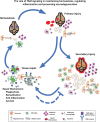TAM Signaling in the Nervous System
- PMID: 34631419
- PMCID: PMC8461745
- DOI: 10.3233/BPL-210125
TAM Signaling in the Nervous System
Abstract
Tyro3, Axl and Mertk are members of the TAM family of tyrosine kinase receptors. TAMs are activated by two structurally homologous ligands GAS6 and PROS1. TAM receptors and ligands are widely distributed and often co-expressed in the same cells allowing diverse functions across many systems including the immune, reproductive, vascular, and the developing as well as adult nervous systems. This review will focus specifically on TAM signaling in the nervous system, highlighting the essential roles this pathway fulfills in maintaining cell survival and homeostasis, cellular functions such as phagocytosis, immunity and tissue repair. Dysfunctional TAM signaling can cause complications in development, disruptions in homeostasis which can rouse autoimmunity, neuroinflammation and neurodegeneration. The development of therapeutics modulating TAM activities in the nervous system has great prospects, however, foremost we need a complete understanding of TAM signaling pathways.
Keywords: Gas6; PROS1; TAM receptors; TAM signaling; homeostasis; immune; nervous system; neurodegeneration; neuroinflammation; phagocytosis; protein S.
© 2021 – The authors. Published by IOS Press.
Conflict of interest statement
The authors declare no potential conflicts of interest with respect to finances, authorship or otherwise related to the publication of this article.
Figures



Similar articles
-
The role of TAM family receptors and ligands in the nervous system: From development to pathobiology.Pharmacol Ther. 2018 Aug;188:97-117. doi: 10.1016/j.pharmthera.2018.03.002. Epub 2018 Mar 4. Pharmacol Ther. 2018. PMID: 29514053 Free PMC article. Review.
-
TAM receptors in phagocytosis: Beyond the mere internalization of particles.Immunol Rev. 2023 Oct;319(1):7-26. doi: 10.1111/imr.13267. Epub 2023 Aug 19. Immunol Rev. 2023. PMID: 37596991 Review.
-
TAM receptor signaling in immune homeostasis.Annu Rev Immunol. 2015;33:355-91. doi: 10.1146/annurev-immunol-032414-112103. Epub 2015 Jan 14. Annu Rev Immunol. 2015. PMID: 25594431 Free PMC article. Review.
-
Loss of Gas6 and Axl signaling results in extensive axonal damage, motor deficits, prolonged neuroinflammation, and less remyelination following cuprizone exposure.Glia. 2017 Dec;65(12):2051-2069. doi: 10.1002/glia.23214. Epub 2017 Sep 19. Glia. 2017. PMID: 28925029 Free PMC article.
-
Requirement of Gamma-Carboxyglutamic Acid Modification and Phosphatidylserine Binding for the Activation of Tyro3, Axl, and Mertk Receptors by Growth Arrest-Specific 6.Front Immunol. 2017 Nov 10;8:1521. doi: 10.3389/fimmu.2017.01521. eCollection 2017. Front Immunol. 2017. PMID: 29176978 Free PMC article.
Cited by
-
TAM family kinases as therapeutic targets at the interface of cancer and immunity.Nat Rev Clin Oncol. 2023 Nov;20(11):755-779. doi: 10.1038/s41571-023-00813-7. Epub 2023 Sep 4. Nat Rev Clin Oncol. 2023. PMID: 37667010 Review.
-
ARL6IP5 Ameliorates α-Synuclein Burden by Inducing Autophagy via Preventing Ubiquitination and Degradation of ATG12.Int J Mol Sci. 2023 Jun 22;24(13):10499. doi: 10.3390/ijms241310499. Int J Mol Sci. 2023. PMID: 37445677 Free PMC article.
-
Therapeutic targeting of the functionally elusive TAM receptor family.Nat Rev Drug Discov. 2024 Mar;23(3):201-217. doi: 10.1038/s41573-023-00846-8. Epub 2023 Dec 13. Nat Rev Drug Discov. 2024. PMID: 38092952 Free PMC article. Review.
-
Computational Interspecies Translation Between Alzheimer's Disease Mouse Models and Human Subjects Identifies Innate Immune Complement, TYROBP, and TAM Receptor Agonist Signatures, Distinct From Influences of Aging.Front Neurosci. 2021 Sep 30;15:727784. doi: 10.3389/fnins.2021.727784. eCollection 2021. Front Neurosci. 2021. PMID: 34658769 Free PMC article.
-
Cell type specific transcriptomic differences in depression show similar patterns between males and females but implicate distinct cell types and genes.Nat Commun. 2023 May 22;14(1):2912. doi: 10.1038/s41467-023-38530-5. Nat Commun. 2023. PMID: 37217515 Free PMC article.
References
-
- Ohashi K, Nagata K, Toshima J, Nakano T, Arita H, Tsuda H, et al.Stimulation of sky receptor tyrosine kinase by the product of growth arrest-specific gene 6. J Biol Chem. 1995;270(39):22681–4. - PubMed
-
- Nagata K, Ohashi K, Nakano T, Arita H, Zong C, Hanafusa H, et al.Identification of the product of growth arrest-specific gene 6 as a common ligand for Axl, Sky, and Mer receptor tyrosine kinases. J Biol Chem.. 1996;271(47):30022–7. - PubMed
-
- Mark MR, Chen J, Glenn Hammonds R, Sadick M, Godowsk PJ. Characterization of Gas6, a member of the superfamily of G domain-containing proteins, as a ligand for Rse and Axl. J Biol Chem. 1996;271(16):9785–9. - PubMed
-
- Stitt TN, Conn G, Goret M, Lai C, Bruno J, Radzlejewski C, et al.The anticoagulation factor protein S and its relative, Gas6, are ligands for the Tyro 3/Axl family of receptor tyrosine kinases. Cell. 1995;80(4):661–70. - PubMed
LinkOut - more resources
Full Text Sources
Research Materials
Miscellaneous
